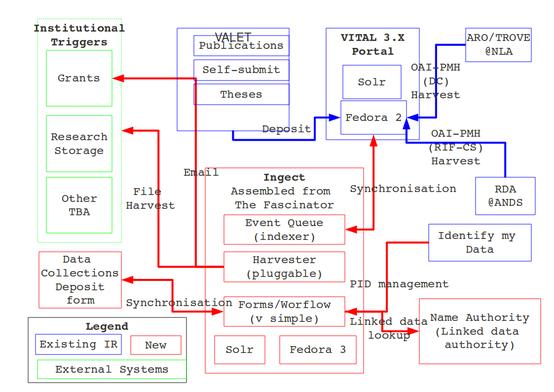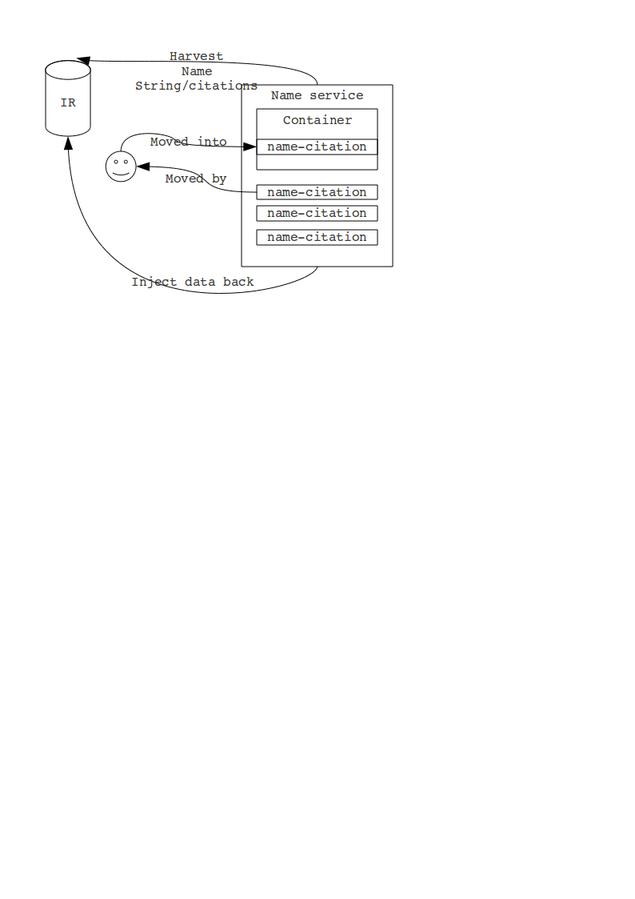Today I am at the National Library, at the “Names Round Table”. I'm part of the ARDCPIPAG, which stands
for “Australian Research Data
Commons Party Identifier Advisory Group”. We're advising a team at the library
who are building party-identifier services for researchers and research
institutions in
Australia.
At my work, at ADFI we're working on
developing specifications for Metadata stores for ANDS. The first cab
off the rank is an application architecture developed with The
University of Newcastle and Swinburne University. I posted about this
earlier this year. ANDS agreed that it would be a good idea to take a
linked data approach to the design of the application. Linked Data is a
non-threatening way of talking about the The Semantic Web, which is
definitely coming real soon now. No, really, 2010 will be the year, or
at the very outside 2012.
Or 2013.
The linked data rules (from Tim Berners-Lee)
Like the web of hypertext, the web of data is constructed with
documents on the web. However, unlike the web of hypertext,
where links are relationships anchors in hypertext documents written
in HTML,
for data they links between arbitrary things described by RDF,.
The URIs identify any kind of object or concept.
But for HTML or RDF, the same expectations apply to make the
web grow:
1. Use URIs as names for things
2. Use HTTP URIs so that people can look up those names.
3. When someone looks up a URI, provide useful information, using the
standards (RDF, SPARQL)
4. Include links to other URIs. so that they can
discover more things.
Simple. In fact, though, a surprising amount of data isn't linked in
2006, because of problems with one or more of the steps. This article
discusses solutions to these problems, details of implementation, and
factors affecting choices about how you publish your data.
http://www.w3.org/DesignIssues/LinkedData.html
Our metadata stores work is covered in blog
posts here.
My presentation today focussed on the name-authority part of the
architecture and looked at the process of establishing name-identities
at an institutional level before joining in a broader federation. I
asked the audience, what is the name we should use for this class of
service? (We're still looking for a name for the metadata-stores app as
well, something better than “The
Fascinator, Research Metadata Store Edition, Pro” or the current working title of “Ingect”.
Architecture - “Ingect” (working title)

What does a Linked Data Approach mean for a metadata stores project?
-
No more typing name-strings into web forms.
-
Agreed names/URIs for things like resource-types.
-
Sorting out URIs for things so that (unlike with Institutional
Repositories) we can:
-
Agree on terms before we start.
-
Match-up terms later if we don't reach agreement.
In our forthcoming collaboration with the UoX we wanted to make sure
that when we named the things in the institution with the role of
'research' or 'owner' of data we used URIs. In ANDS speak, these things
are 'parties'. Some of the are people, some are institutions,
organisations, or organisational units.
Goal: Establish URIs for person-parties at UoX before we start
So, a simple matter of:
-
Extracting name data from the existing institutional repository
(the UoX model is to build their metadata store so collections are
described in the IR)
-
Disambiguating name-strings, for the usual reasons; there is
typically more than one string used to refer to the same person and
often the same string used to refer to more than one person. Sorry,
party.
-
Establishing new URIs for each party that the UoX cares about
(they don't care about parties from UoY).
-
Injecting the URIs back in to the IR.
Establishing IDs? How?
We considered these options.
-
Use People Australia / ARDC-PIP services. (It was a bit early)
-
Use Nicnames (plus).
-
Use a combination of the above.
We chose option 4
Build a name-authority server inspired by and informed by the NicNames
work.
Why?
-
Can ship as an integrated part of the broader application we are
building, in the same language (Java).
-
Easy-install under the same web container as Fedora and
Solr.
-
Same configuration files as the “Ingect” application.
-
Having a local service means we can use:
-
Private data such as staff-IDs internal to the application.
-
Local URI-schemes for local things, such as internal
projects.
-
Our service will deal with JSON formatted , not RDF to make it
easy for web-interface designers.
The process – disambiguating names
-
Import all the name-string/publication pairs from the IR into a new
repository (in EAC format) .
That's one for each name on a paper. Records will be presented as
citations keyed by a name.
name:<name-string> id:<pID> title:<dc:title> (subject:<dc:subject>)*
-
Import a set of canonical names we care about into the new
repository.
-
Turn all the canonical names from a local directory into
master-records/name-packages.
-
Allow a data librarian to drag all the name-strings into the
name-packages.
[Jane Hunter CONTAINER RECORD
Hunter, J: Gerber, A. and Hunter, J. (2008). A compound object authoring and publishing tool for literary scholars based on the IFLA-FRBR. In: C. Rusbridge, A. Trefethen and D. Berry, Proceedings of: 4th International Digital Curation Conference "Radical Sharing: Transforming Science?". ``4th International Digital Curation Conference (IDCC 2009)``, Edinburgh, Scotland, (1-10). 1-3 December 2008.
Hunter, Jane: Hunter, Jane (2001). Adding Multimedia to the Semantic Web: Building an MPEG-7 Ontology. In:``International Semantic Web Working Symposium (SWWS)``, Stanford University, California, (). July, 2001.
Hunter, J.: Hunter J. (1999). An "Improved" Proposal for an MPEG-7 DDL. ISO/IEC JTC1/SC29/WG11, 47th MPEG Meeting M4518, .
...
]
``
Process

But wait! There's more!
This new module, which is called, um … will:
-
'Mint' a new URI whenever someone types a string (in desperation).
-
Provide locally available, fast services for accessing any ontology.
Eg:
Oh, and nobody at the ARDCPIP round table had an answer for me about
what we call this class of name-authority linked-data-endpoint-factory
application.

